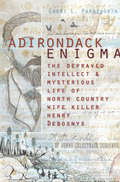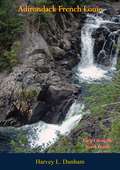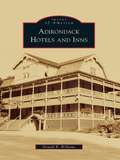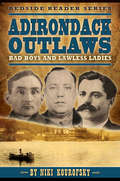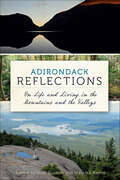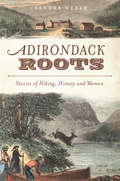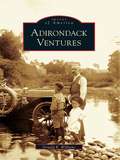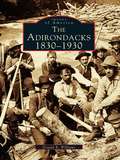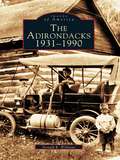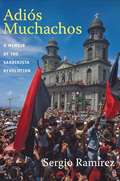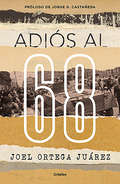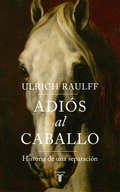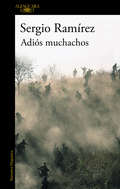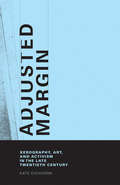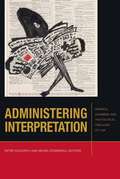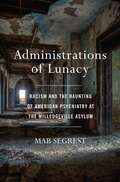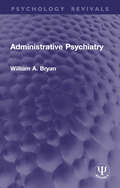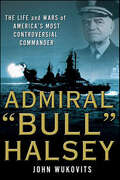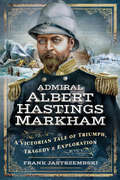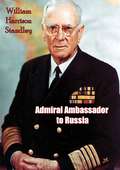- Table View
- List View
Adirondack Enigma: The Depraved Intellect and Mysterious Life of North Country Wife Killer Henry Debosnys
by Cheri L. FarnsworthWhen Henry Debosnys arrived in Essex, New York, the sleepy town was unprepared for the string of dark events that trailed the exotic European stranger. Within weeks of his appearance, he had romanced wealthy widow Betsey Wells, charming her friends and children and presenting the picture of an ideal new family at their spur-of-the-moment wedding. Yet when authorities discovered Betsey's mangled body in a nearby forest, Debosnys's image as a caring family man began to unravel. During his incarceration, Debosnys slowly revealed himself to be a genius fluent in six languages, a master cryptographer and the murderer of at least two previous wives. As the scrutiny on Debosnys intensified, he began producing coded messages, allegedly confessions to a lifetime of villainy. Author Cheri Farnsworth reveals never-before-seen evidence of this Upstate tragedy, including reproductions of the legendary, unsolved Debosnys cryptograms, in an effort to finally uncover the truth about this depraved con man. The only question that remains is who will be the first to crack the "Debosnys Code"?
Adirondack French Louie: Early Life in the North Woods
by Harvey L. DunhamAlthough numerous books have been written about the Adirondacks and Adirondackers, not very many have become regional classics. Early authors such as John Todd, Charles Fenno Hoffman, Jeptha R. Simms, S. H. Hammond, J. T. Headly, Alfred B. Street, William H.H. Murray and Verplanck Colvin earned well-deserved popularity in their day and their literary output still exerts a potent appeal more than a century later. One more volume is eminently entitled to consideration as top-bracket upstate literature...and that is Adirondack French Louie by the late Harvey L. Dunham of Utica.
Adirondack Hotels and Inns
by Donald R. WilliamsThe Adirondack region evolved over years from vast, impassable wilderness to a land of logging camps, tanneries, sawmills, and small settlements. By the end of the 19th century, the area grew again, becoming a tourist destination famed for its great hotels, quaint inns, cottages, and rustic cabins. The hotels and inns spread throughout the Adirondacks, beginning after the Civil War and continuing during the Gilded Age between World Wars I and II. The region drew the rich and famous, as well as workers and families escaping the polluted cities. This volume contains 200 vintage images of those famed accommodations that catered to years of Adirondack visitors. Most of the buildings seen in this book no longer exist, having been destroyed by fires, the wrecking ball, or simply forgotten over time. Adirondack Hotels and Inns provides a timeless look at the vacation retreats of the past.
Adirondack Outlaws: Bad Boys and Lawless Ladies
by Niki KourofskyLocal author and historian Niki Kourofsky exposes the North Country's shadowy past of crime and dark deeds. Her wry, lively storytelling puts readers right in the thick of shootouts, jewel heists, bank robberies, manhunts, and unsolved murders. Spanning eight decades of Adirondack history and ranging from Glens Falls to the Canadian border, Adirondack Outlaws is a rollicking page-turner, rich in chilling details and amply illustrated with historical photographs.
Adirondack Reflections: On Life and Living in the Mountains and the Valleys
by Neal Burdick and Maurice KennyThe Adirondacks have been written about since they were first spied by Europeans more than five hundred years ago. Yet for most of the intervening centuries, few of those writers lived in the region of which they wrote--they were not part of the landscape. That has changed in recent years as writers have moved to the Adirondacks and formed a literary community. Perhaps inspired by these writers, longtime residents have discovered that they, too, could be part of such a community. From scratching out a living in the harsh landscape to the wonders of a moonlit cross-country ski, these writers celebrate life in the Adirondacks. In this remarkable collection of essays, the experiences of Adirondack natives are interwoven with the land in a part of America that is both demanding and rewarding.
Adirondack Roots: Stories of Hiking, History and Women (American Chronicles)
by Sandra WeberThe Adirondack Mountains captivate inhabitants, fostering deep roots and rich memories. In this diverse collection, local author Sandra Weber celebrates this enduring bond with the region and explores its roots and routes--such as women's feats, the naming of mountain peaks and the fight to save forests and tiny alpine plants. From Heart Lake and Caribou Pass to Mount Marcy and Lake Tear, ride an Olympic bobsled run, unearth the destruction of a devastating fire and discover the healing powers of the mountains. Retrace the paths of Theodore Roosevelt, Martha Reben, Edwin Ketchledge, Grace Hudowalski and many others who have lived in and loved the Adirondacks. Unearth hikers' tales, nature's secrets and local legends in this collection of Weber's finest reflections on Adirondack historical adventures.
Adirondack Ventures
by Donald R. WilliamsAdirondack Ventures explores the early man-made features that were introduced into New York State's great mountain and lake region. With some 200 rare photographs, this book recounts the memories of those who took part in the development of the Adirondacks, an area that covers one quarter of the state. To open up these millions of acres, pathways and roadways and, later, small airports and railways were constructed. To enhance the use and enjoyment of the wilderness, bikeways and ski slopes, as well as amusement parks and golf courses, were built.
Adirondacks, The
by Scherelene L. SchatzIn 1892, the Adirondack Park, located in the northeast corner of New York, was declared "forever wild," and from then on, public land could not be further developed. Early on, tourists were drawn to the clear blue lakes, winding rivers and streams, and awe-inspiring mountain peaks of the region. The stunning scenery of the Adirondacks suited the postcard perfectly, making the medium the primary method park visitors used to correspond with family and friends, whether on a trip for healing from tuberculosis and other breathing disorders or vacationing from New York City and the surrounding area. Today the park remains an unspoiled wilderness that continues to draw visitors eager to enjoy its natural beauty.
Adirondacks, The: 1830-1930 (Images of America)
by Donald R. WilliamsThe East's greatest wilderness, the Adirondack region of New York State, shares its history and lore with Native Americans, early settlers, artists, writers, sportsmen, professors, and others. The Adirondacks are known to outdoor lovers, skiers, and year-round visitors for their forty-six high peaks, one-hundred-mile canoe route, one-hundred-thirty-three-mile Northville-to-Lake Placid Trail, thirty thousand miles of mountain streams, and three thousand lakes. The Adirondacks: 1830-1930, tells how the region was first "discovered," explored, and preserved as the six-million-acre Adirondack Park, the largest park in the contiguous United States, a patchwork of public and private lands governed by one of the largest regional zoning plans in the country. With more than two hundred stunning photographs and fascinating tales of the region, it traces the development of the hamlets, the great camps, the guides, and the furniture and tanning businesses.
Adirondacks, The: 1931-1990
by Donald R. WilliamsFor decades, the vast Adirondack wilderness has beckoned. Some, having sampled the treasury of Adirondack art and literature, are drawn by its spectacular beauty; many are lured by its year-round sports and recreational opportunities; others are enticed by its health-giving qualities-the clear air, sparkling waters, and refreshing woodlands. The Adirondacks: 1931-1990 celebrates the years in which the six-million-acre preserve truly became a people's park. With some two hundred rare images, the book includes views of the Winter Olympics held at Lake Placid in 1932, attended by thousands from the world over. It applauds the American boys working in the CCC camps in the Adirondacks during the Great Depression. It follows the steamboats as they ply Lake George and the Fulton Chain and other lakes, as well as the railroads as they bring in more and more visitors. It traces the rise and fall of the grand hotels and their successors: the cabins, motels, cottages, second homes, and campsites of the motoring public. It highlights the music, the architecture, the animals, the crafts-the more recent history of the Adirondack culture.
Adiós Muchachos: A Memoir of the Sandinista Revolution
by Sergio Ramírez Stacey Alba SkarAdiós Muchachos is a candid insider's account of the leftist Sandinista revolution in Nicaragua. During the 1970s, Sergio Ramírez led prominent intellectuals, priests, and business leaders to support the Sandinista National Liberation Front (FSLN), against Anastasio Somoza's dictatorship. After the Sandinistas overthrew the Somoza regime in 1979, Ramírez served as vice-president under Daniel Ortega from 1985 until 1990, when the FSLN lost power in a national election. Disillusioned by his former comrades' increasing intolerance of dissent and resistance to democratization, Ramírez defected from the Sandinistas in 1995 and founded the Sandinista Renovation Movement. In Adiós Muchachos, he describes the utopian aspirations for liberation and reform that motivated the Sandinista revolution against the Somoza regime, as well as the triumphs and shortcomings of the movement's leadership as it struggled to turn an insurrection into a government, reconstruct a country beset by poverty and internal conflict, and defend the revolution against the Contras, an armed counterinsurgency supported by the United States. Adiós Muchachos was first published in 1999. Based on a later edition, this translation includes Ramírez's thoughts on more recent developments, including the re-election of Daniel Ortega as president in 2006.
Adiós al 68
by Joel Ortega Juárez¿Qué queda hoy de una generación a la que se le puede reclamar tanto como se le debe? Adiós al 68 rechaza la mirada contemplativa con la que se ha construido la memoria de los movimientos sociales de la segunda mitad del siglo XX y lo que va del XXI. Con la dolorosa valentía que requiere la autocrítica, confronta al fantasma de aquellos que formaron la conciencia de un mundo mejor, pero que sólo lograron moldear uno distinto. Joel Ortega, quizá el más inteligente miembro activo de la generación mexicana de los años sesenta, hace un recorrido obligadamente incómodo que va de la ilusión a la integración en la política, producto de la Revolución que se deconstruyó para situarse en sus similitudes. Este libro no es sólo el testimonio más honesto que he leído sobre lo que vivió la generación de mis padres, es el retrato de un sobreviviente del 2 de octubre del 68 y del 10 junio del 71, donde convergen Lucio Cabañas, la Liga Comunista 23 de Septiembre, la Unión Soviética, el EZLN, el rechazo al poder hegemónico, la transición de la izquierda a la legalidad y la partidocracia. Este diario político -especie de testamento ideológico- es la crónica de una vida dedicada a pensar, de la metamorfosis de aquella lucha y el anuncio del fin de un ciclo histórico. Maruan Soto Antaki
Adiós al caballo: Historia de una separación
by Ulrich RaulffLa historia del animal que dio forma a nuestro mundo. Este libro es un recorrido a caballo por la historia mundial. El arte, la literatura y la historia occidental han estado marcados por nuestro vínculo con este extraordinario animal, presente en la vida y el imaginario de conquistadores, viajeros, trabajadores o artistas, y arrinconado en las últimas décadas. Durante milenios, aportaron la fuerza y velocidad que nos faltaba a los humanos, y determinaron el modo en que viajábamos, cultivábamos y luchábamos. Su intervención fue fundamental en innumerables eventos históricos, y ciudades, tierras de cultivo e industrias enteras se adaptaban antaño a sus necesidades. Se esculpían, pintaban, admiraban. Del Imperio romano al napoleónico, todo conquistador debía ser mostrado a caballo. Tolstoi aseguraba haber acumulado unos nueve años de su vida cabalgando. En el siglo XX se rompieron los lazos, y los millones de caballos con los que compartíamos nuestras vidas prácticamente desaparecieron, relegados a las carreras y los clubs de ponis. Adiós al caballo es una reflexión emocionante y brillantemente escrita sobre lo que los caballos significaron para nosotros. Reseñas:«Una hermosa exploración del papel del caballo en la creación de nuestro mundo.»James Rebanks «Una elegía a la forma en que los caballos han galopado por nuestra cultura.»Melanie Reid, The Times «Raulff está tan cómodo haciendo análisis etimológicos como reflexionando sobre la Escuela de Chicago, Clint Eastwood o las míticas Amazonas, sin perder a ningún lector por el camino. Tan rápido y emocionante como un cosaco al galope. Nos descubre una red de conexiones vertiginosa, y se acerca a temas supuestamente conocidos desde ángulos completamente novedosos.»Susannah Forrest, Literary Review «Un tour de force tan brillante como divertido.»Die Zeit «Brillante, emocionante... Nunca has leído un libro como éste. Una nueva forma de contar la historia.»The Observer «Brillante, emocionante... Nunca has leído un libro como éste. Una nueva forma de contar la historia. La habilidad de Raulff para llevar al redil a los caballos dispersos en el arte, la literatura y la vida vuelve la lectura deslumbrante y estimulante.»Kate Kellaway, The Observer «Una historia fascinante repleta de historias.»Neue Zürcher Zeitung «Historia cultural en su máxima expresión.»Der Tagesspiegel «Ulrich Raulff es un maravilloso contador de historias.»Südwestrundfunk
Adiós muchachos
by Sergio Ramírez«No había leído la autobiografía de Sergio Ramírez, Adiós muchachos, y acabo de hacerlo, conmovido. Es un libro sereno, muy bien escrito.»Mario Vargas Llosa, Piedra de toque, El País. Una novela del ganador del Premio Cervantes 2017. Con la pérdida de las elecciones generales en 1990, el proceso iniciado por la revolución sandinista contra el dictador Somoza en 1979 se detuvo en seco, y con él también se difuminaron los sueños, anhelos y esperanzas de cientos de miles de ciudadanos que participaron en aquel proceso transformador. Sergio Ramírez, miembro de la dirigencia revolucionaria y vicepresidente en la fórmula con Daniel Ortega, fue testigo excepcional de una utopía que se extendió más allá de las fronteras nicaragüenses. Adiós muchachos es la memoria de una generación que luchó por unos ideales de rebeldía comunes, y que, si bien no pudo ver cumplidos todos sus objetivos de justicia, riqueza y desarrollo, siente el orgullo de haber traído la democracia a su país, Nicaragua, cuando las ideologías parecen desvanecerse. Esta edición lleva un nuevo prólogo del autor, que pone en perspectiva sus reflexiones críticas tras el regreso al poder del Frente Sandinista, con el propio Daniel Ortega a la cabeza. Reseñas:«El talento narrativo del autor domina este libro. Rescata del olvido una revolución que despertó enormes esperanzas y conmovidas adhesiones.»Javier Pradera, Babelia «Más allá de las ideologías Adiós muchachos encierra el interés de lo auténtico y lo honesto.»Carmen Rodríguez Santos, ABC
Adjusted Margin: Xerography, Art, and Activism in the Late Twentieth Century
by Kate EichhornHow xerography became a creative medium and political tool, arming artists and activists on the margins with an accessible means of making their messages public. This is the story of how the xerographic copier, or “Xerox machine,” became a creative medium for artists and activists during the last few decades of the twentieth century. Paper jams, mangled pages, and even fires made early versions of this clunky office machine a source of fear, rage, dread, and disappointment. But eventually, xerography democratized print culture by making it convenient and affordable for renegade publishers, zinesters, artists, punks, anarchists, queers, feminists, street activists, and others to publish their work and to get their messages out on the street. The xerographic copier adjusted the lived and imagined margins of society, Eichhorn argues, by supporting artistic and political expression and mobilizing subcultural movements. Eichhorn describes early efforts to use xerography to create art and the occasional scapegoating of urban copy shops and xerographic technologies following political panics, using the post-9/11 raid on a Toronto copy shop as her central example. She examines New York's downtown art and punk scenes of the 1970s to 1990s, arguing that xerography—including photocopied posters, mail art, and zines—changed what cities looked like and how we experienced them. And she looks at how a generation of activists and artists deployed the copy machine in AIDS and queer activism while simultaneously introducing the copy machine's gritty, DIY aesthetics into international art markets.Xerographic copy machines are now defunct. Office copiers are digital, and activists rely on social media more than photocopied posters. And yet, Eichhorn argues, even though we now live in a post-xerographic era, the grassroots aesthetics and political legacy of xerography persists.
Adjusting to Global Economic Change: The Dangerous Road Ahead
by David R. Frelinger James T. Bartis Robert A. LevineThe author combines macroeconomic history since the Great Depression with a brief exposition of economic theory that stems from and explains that history, and explores how that experience may apply to the present economic crisis. He warns that we may again be headed for stagflation and makes suggestions for escaping the worst effects of the crisis.
Adlai E. Stevenson and American Intellectuals: The Terms of Endearment
by C. Baars BultmanThis book focuses on a biographical and cultural rendering of Adlai E. Stevenson's alliance with a segment of the intellectual community, with primary attention to the years from 1940 to his death in 1965. At the core of the study is an evaluation of the nature of a relationship that was important both to intellectuals, particularly literary intellectuals, and to Stevenson. This volume exhibits case studies which illumine the alliance through a view of Stevenson's relations with American writers Archibald MacLeish and John Steinbeck.
Administering Interpretation: Derrida, Agamben, and the Political Theology of Law (Just Ideas)
by Peter Goodrich and Michel RosenfeldPopulism in politics and policy orientations in law have thrown the jurisdiction of the academy and the disciplines of interpretation into disarray. Critique flounders in abstraction and negativity, law loses itself in particularity. Administering Interpretation brings together philosophers, humanists, and jurists from both continental and Anglophone jurisdictions to reassess the status and trajectory of interpretative theory as applied in the art of law. Tracking the thread of philosophical influences upon the community of legal interpretation, the essays move from the translation and wake of Derrida to the work of Agamben, from deconstruction to oikononmia. Sharing roots in the philological excavation of the political theology of modern law, contributors assess the failure of secularism and the continuing theological borrowings of juridical interpretation. The book brings contemporary critique to bear upon the interpretative apparatuses of exclusion, the law of spectacular sovereignty, and the bodies that lie in its wake.Contributors: Giovanna Borradori, Marinos Diamantides, Allen Feldman, Stanley Fish, Pierre Legrand, Bernadette Meyler, Michel Rosenfeld, Bernhard Schlink, Jeanne Schroeder, Laurent de Sutter, Katrin Trüstedt, Marco Wan
Administration and Organization of War in Thirteenth-Century England (Variorum Collected Studies)
by David S. BachrachThe essays brought together in this volume examine the conduct of war by the Angevin kings of England during the long thirteenth century (1189-1307). Drawing upon a wide range of unpublished administrative records that have been largely ignored by previous scholarship, David S. Bachrach offers new insights into the military technology of the period, including the types of artillery and missile weapons produced by the royal government. The studies in this volume also highlight the administrative sophistication of the Angevin kings in military affairs, showing how they produced and maintained huge arsenals, mobilized vast quantities of supplies for their armies in the field, and provided for the pastoral care of their men. Bachrach also challenges the knight-centric focus of much of the scholarship on this period, demonstrating that the militarization of the English population penetrated to men in the lower social and economic strata, who volunteered in large numbers for military service, and even made careers as professional soldiers.
Administrations Of Lunacy: Racism And The Haunting Of American Psychiatry At The Milledgeville Asylum
by Mab SegrestA scathing and original look at the racist origins of psychiatry, through the story of the largest mental institution in the world Today, 90 percent of psychiatric beds are located in jails and prisons across the United States, institutions that confine disproportionate numbers of African Americans. After more than a decade of research, the celebrated scholar and activist Mab Segrest locates the deep historical roots of this startling fact, turning her sights on a long-forgotten cauldron of racial ideology: the state mental asylum system in which psychiatry was born and whose influences extend into our troubled present. In December 1841, the Georgia State Lunatic, Idiot, and Epileptic Asylum was founded. A hundred years later, it had become the largest insane asylum in the world with over ten thousand patients. Administrations of Lunacy tells the story of this iconic and infamous southern institution, a history that was all but erased from popular memory and within the psychiatric profession. Through riveting accounts of historical characters, Segrest reveals how modern psychiatric practice was forged in the traumas of slavery, the Civil War, Reconstruction, and Jim Crow. Deftly connecting this history to the modern era, Segrest then shows how a single asylum helped set the stage for the eugenics theories of the twentieth century and the persistent racial ideologies of our own times. She also traces the connections to today’s dissident psychiatric practices that offer sanity and create justice. A landmark of scholarship, Administrations of Lunacy restores a vital thread between past and present, revealing the tangled racial roots of psychiatry in America.
Administrative Psychiatry (Psychology Revivals)
by William A. BryanOriginally published in 1937, Administrative Psychiatry was the first book to present theory and practice in a hospital for psychiatric patients. Every detail of the organization and direction of a psychiatric hospital is described in this volume. Everything advocated in this volume had passed the test of actual trial, the principles set forth having been in continuous operation over a period of years before the book was written. A pioneering text at the time, today it can be read in its historical context.This book is a re-issue originally published in 1937. The language used is a reflection of its era and no offence is meant by the Publishers to any reader by this re-publication.
Administrators of Empire (Routledge Revivals)
by Mark A. BurkholderPublished in 1998, the expansion of Europe overseas required the creation of institutions for governing the conquered peoples, as well as the conquerors, their descendants, and later immigrants. As a group, bureaucrats were essential for the preservation of extensive and long-lasting European colonies. This volume looks in particular at the Americas and sets out the differing responses of Portugal, Spain, Britain and France and the systems they elaborated. A notable theme is the conflict between the demands of the centre, and the local pressures, and the extent to which the bureaucrats often came to identify with these.
Admiral "Bull" Halsey: The Life and Wars of America's Most Controversial Commander
by John WukovitsThe definitive biography of America's best-known naval officer, who commanded the legendary fast carrier force during WWII.From the tragic aftermath of Pearl Harbor, when he fashioned America's first response to the attack, to the war's final day in Tokyo Bay when he witnessed Japan's surrender, Admiral William F. Halsey stamped a mighty imprint on the Pacific during World War II. He led or participated significantly in the Navy's first offensive strikes against the Marshall Islands and Wake Island, the Guadalcanal campaign, and the offensive toward Japan. As a commander, he never shied from engaging the enemy, but boldly entered into battle, ready for a fight. As a consequence, Halsey became the face of the Navy and its most attractive public relations phenomenon. Due to his bold tactics and quotable wit, Halsey continues to be a beloved and debated figure.In this balanced biography, historian John Wukovits illuminates the life of a man who ultimately deserves recognition as one the great naval commanders in U.S. history. Europe had Patton; the Pacific had Admiral William "the Bull" Halsey.
Admiral Albert Hastings Markham: A Victorian Tale of Triumph, Tragedy & Exploration
by Frank JastrzembskiThe story of a 19th-century adventurer who battled pirates, hunted buffalo, sailed the Arctic, and was “one of the most arresting figures of his time” (The Globe).Few men have lived such an extraordinary life as Admiral Albert Hastings Markham. Besides dedicating five decades of his career to Britain’s Royal Navy, Markham was a voracious reader, prolific writer, keen naturalist, and daring explorer. He battled Chinese pirates during the Second Opium War and Taiping Rebellion; chased down Australian blackbirding ships in the South Pacific; trekked to within 400 miles of the North Pole; hunted buffalo and visited Indian reservations in the United States; observed a bloody war in South America; canoed Canada’s remote Hayes River; and explored the icy waters of Baffin Bay and the Arctic Ocean archipelago of Novaya Zemlya. At the time of his death in 1918, The Globe declared that Markham had been “one of the most arresting figures of his time.”While Markham’s life was filled with adventure, it was also marred by tragedy. Regrettably, Markham is best remembered for his role in the sinking of HMS Victoria in 1893. This one incident has tarnished his legacy until now. This book follows Markham through his adventures and misfortunes—and reassesses the life of this forgotten yet fascinating admiral.
Admiral Ambassador to Russia
by William Harrison StandleyWilliam Harrison Standley’s Admiral Ambassador to Russia is a riveting firsthand account of the author’s dual roles as a distinguished naval officer and U.S. ambassador to the Soviet Union during a pivotal period in history. This memoir offers unique insights into the complexities of diplomacy and military strategy during World War II, as seen through the eyes of a man who navigated both arenas with skill and determination.Admiral Standley recounts his time as a senior naval officer, including his role as Chief of Naval Operations, before transitioning to his diplomatic post in the USSR in 1942. As ambassador, he worked to strengthen the fragile alliance between the United States and the Soviet Union, addressing the challenges of cultural and ideological differences while managing critical wartime negotiations.The book provides a rare glimpse into Standley’s interactions with key figures such as Joseph Stalin and Franklin D. Roosevelt, offering candid observations on the political dynamics and tensions of the time. Standley’s narrative combines vivid descriptions of wartime Moscow, keen insights into Soviet-American relations, and reflections on the difficulties of building trust between allies with starkly different worldviews.Admiral Ambassador to Russia is not only a compelling personal story but also an invaluable historical document that sheds light on the challenges of diplomacy during one of the most consequential conflicts in modern history. Standley’s blend of military expertise and diplomatic candor makes this memoir a must-read for history enthusiasts, military scholars, and anyone interested in the intricate dance of international relations during World War II.
